Social Impact Assessment: Internet of Things - ICT521 Assignment 2
VerifiedAdded on 2023/06/12
|14
|3636
|453
Report
AI Summary
This report provides a social impact assessment of the Internet of Things (IoT), exploring its potential to disrupt current societal functions and offering a detailed look into the risks and opportunities presented by this technology. It discusses the ethical responsibilities of the ICT workforce in supporting the integration of IoT into businesses and daily life, referencing real-world examples like Telefónica's IoT solutions. The report also analyzes the challenges of managing huge data volumes and ensuring security, emphasizing the need for innovation and government support. Furthermore, it examines the ethical considerations within IoT, categorizing ethics into member and organizational levels. The document concludes with recommendations and insights into leveraging IoT for continuous competitive advantage, highlighting the importance of innovation, quality management, and social responsibility in the context of technological advancement. Desklib provides more solved assignments and study material for students.
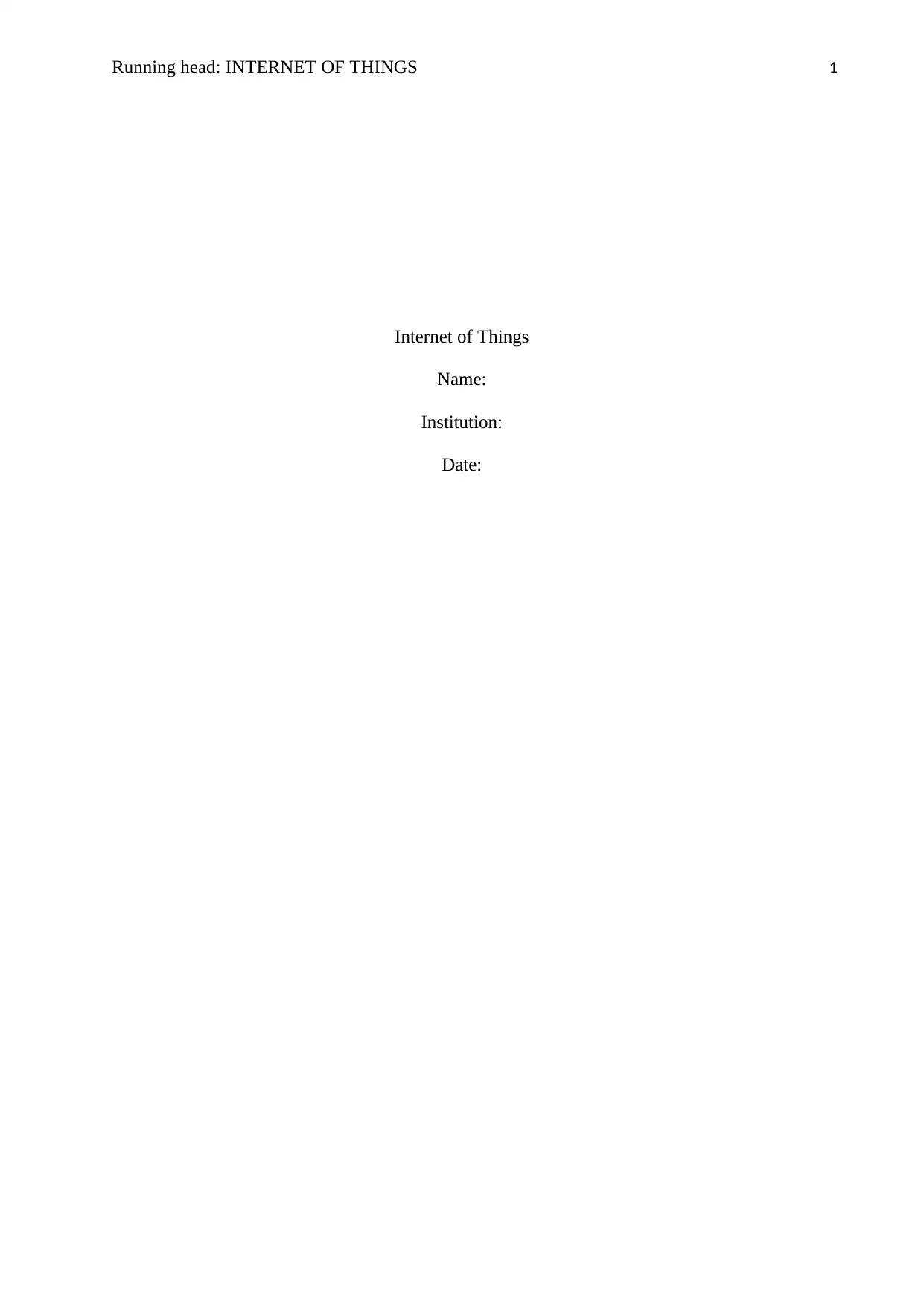
Running head: INTERNET OF THINGS 1
Internet of Things
Name:
Institution:
Date:
Internet of Things
Name:
Institution:
Date:
Paraphrase This Document
Need a fresh take? Get an instant paraphrase of this document with our AI Paraphraser
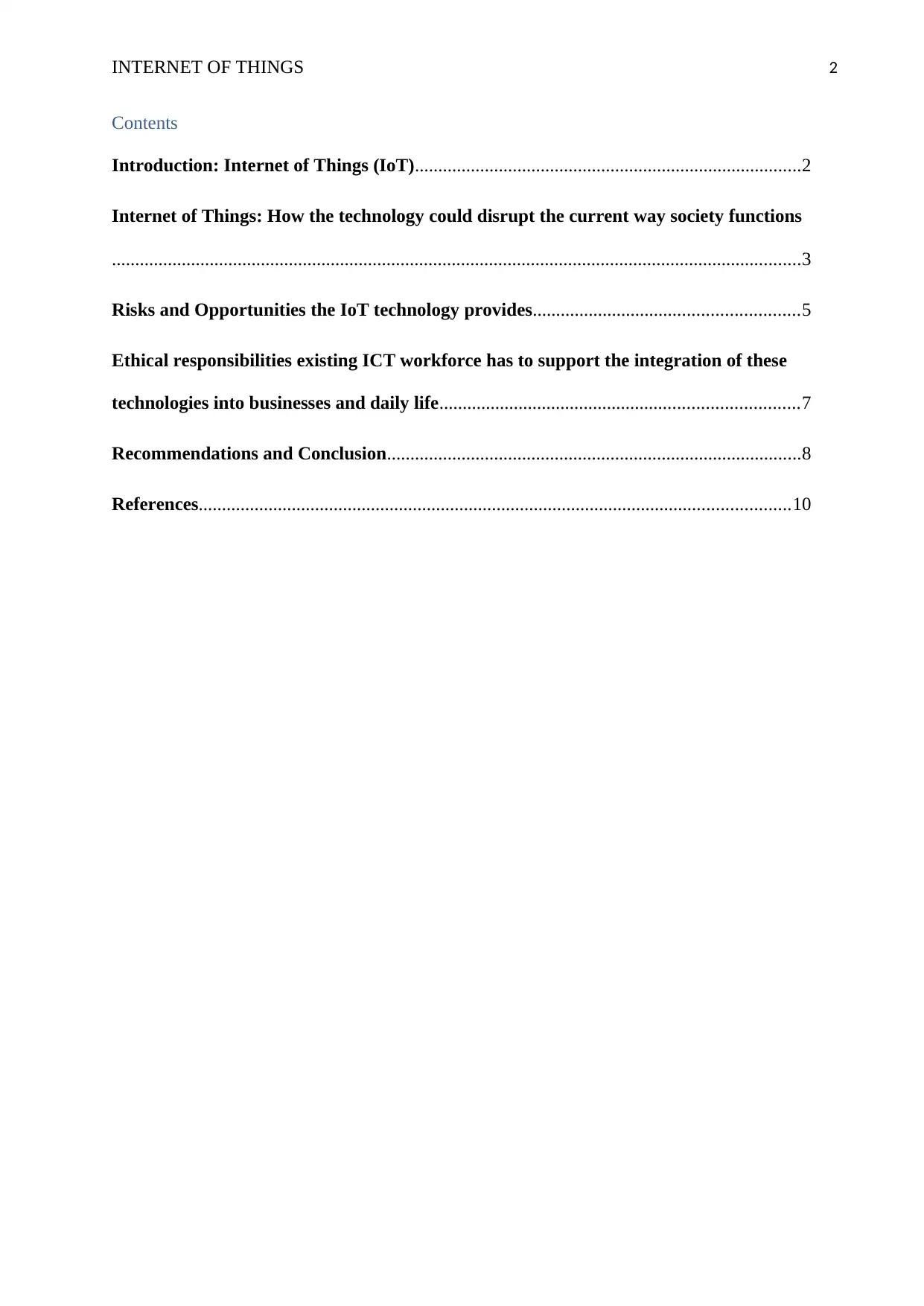
INTERNET OF THINGS 2
Contents
Introduction: Internet of Things (IoT)...................................................................................2
Internet of Things: How the technology could disrupt the current way society functions
....................................................................................................................................................3
Risks and Opportunities the IoT technology provides.........................................................5
Ethical responsibilities existing ICT workforce has to support the integration of these
technologies into businesses and daily life.............................................................................7
Recommendations and Conclusion.........................................................................................8
References...............................................................................................................................10
Contents
Introduction: Internet of Things (IoT)...................................................................................2
Internet of Things: How the technology could disrupt the current way society functions
....................................................................................................................................................3
Risks and Opportunities the IoT technology provides.........................................................5
Ethical responsibilities existing ICT workforce has to support the integration of these
technologies into businesses and daily life.............................................................................7
Recommendations and Conclusion.........................................................................................8
References...............................................................................................................................10
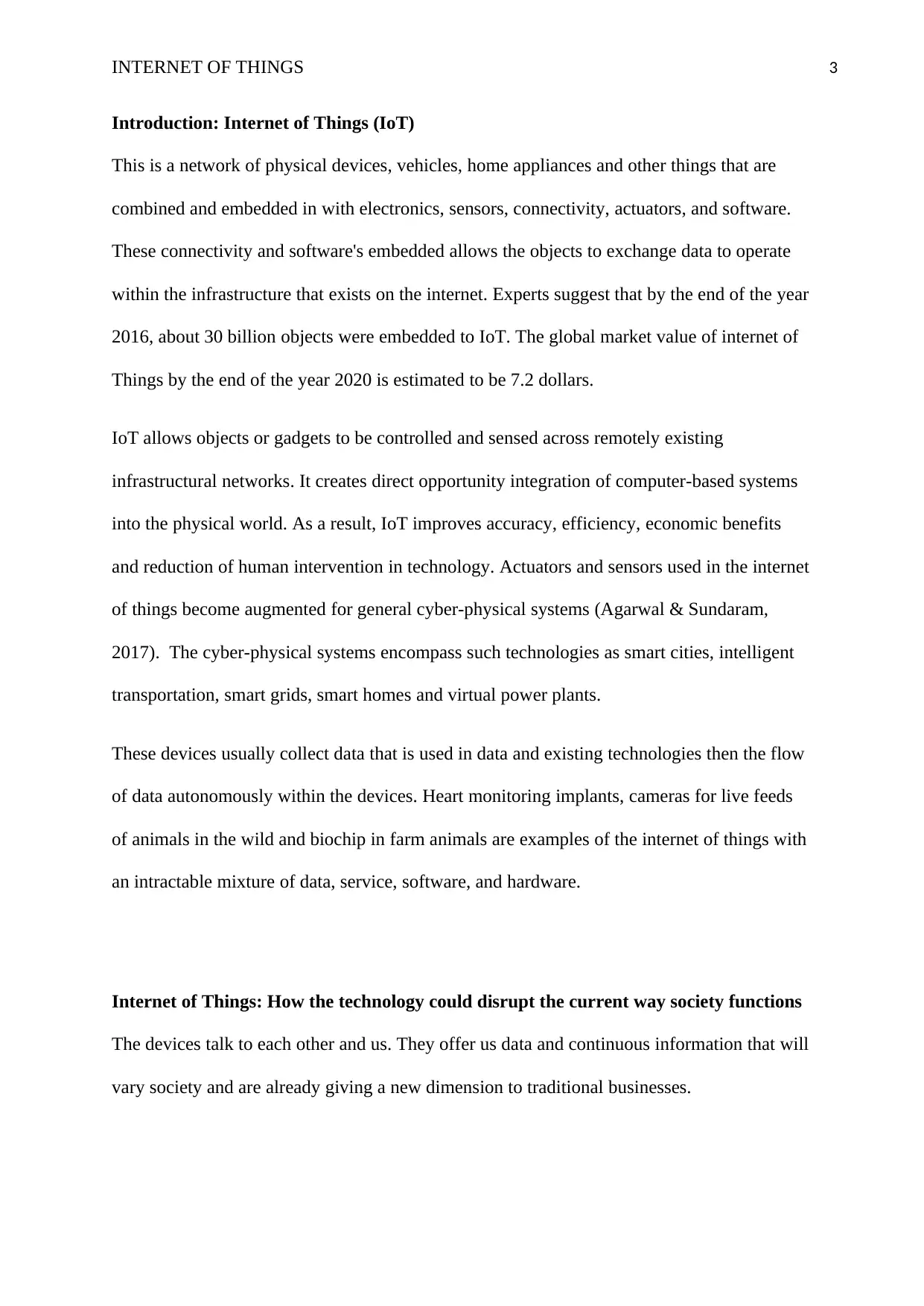
INTERNET OF THINGS 3
Introduction: Internet of Things (IoT)
This is a network of physical devices, vehicles, home appliances and other things that are
combined and embedded in with electronics, sensors, connectivity, actuators, and software.
These connectivity and software's embedded allows the objects to exchange data to operate
within the infrastructure that exists on the internet. Experts suggest that by the end of the year
2016, about 30 billion objects were embedded to IoT. The global market value of internet of
Things by the end of the year 2020 is estimated to be 7.2 dollars.
IoT allows objects or gadgets to be controlled and sensed across remotely existing
infrastructural networks. It creates direct opportunity integration of computer-based systems
into the physical world. As a result, IoT improves accuracy, efficiency, economic benefits
and reduction of human intervention in technology. Actuators and sensors used in the internet
of things become augmented for general cyber-physical systems (Agarwal & Sundaram,
2017). The cyber-physical systems encompass such technologies as smart cities, intelligent
transportation, smart grids, smart homes and virtual power plants.
These devices usually collect data that is used in data and existing technologies then the flow
of data autonomously within the devices. Heart monitoring implants, cameras for live feeds
of animals in the wild and biochip in farm animals are examples of the internet of things with
an intractable mixture of data, service, software, and hardware.
Internet of Things: How the technology could disrupt the current way society functions
The devices talk to each other and us. They offer us data and continuous information that will
vary society and are already giving a new dimension to traditional businesses.
Introduction: Internet of Things (IoT)
This is a network of physical devices, vehicles, home appliances and other things that are
combined and embedded in with electronics, sensors, connectivity, actuators, and software.
These connectivity and software's embedded allows the objects to exchange data to operate
within the infrastructure that exists on the internet. Experts suggest that by the end of the year
2016, about 30 billion objects were embedded to IoT. The global market value of internet of
Things by the end of the year 2020 is estimated to be 7.2 dollars.
IoT allows objects or gadgets to be controlled and sensed across remotely existing
infrastructural networks. It creates direct opportunity integration of computer-based systems
into the physical world. As a result, IoT improves accuracy, efficiency, economic benefits
and reduction of human intervention in technology. Actuators and sensors used in the internet
of things become augmented for general cyber-physical systems (Agarwal & Sundaram,
2017). The cyber-physical systems encompass such technologies as smart cities, intelligent
transportation, smart grids, smart homes and virtual power plants.
These devices usually collect data that is used in data and existing technologies then the flow
of data autonomously within the devices. Heart monitoring implants, cameras for live feeds
of animals in the wild and biochip in farm animals are examples of the internet of things with
an intractable mixture of data, service, software, and hardware.
Internet of Things: How the technology could disrupt the current way society functions
The devices talk to each other and us. They offer us data and continuous information that will
vary society and are already giving a new dimension to traditional businesses.
⊘ This is a preview!⊘
Do you want full access?
Subscribe today to unlock all pages.

Trusted by 1+ million students worldwide
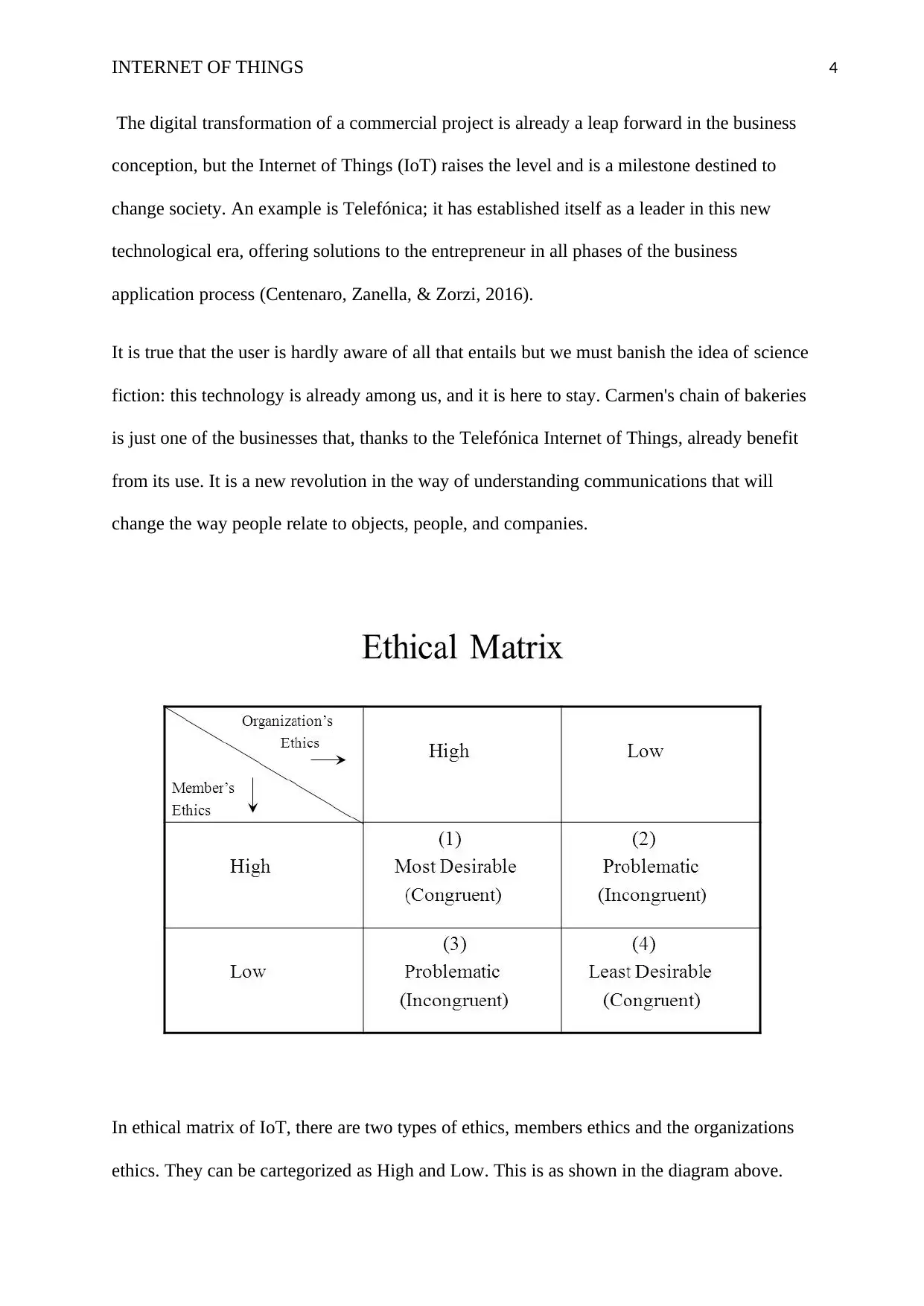
INTERNET OF THINGS 4
The digital transformation of a commercial project is already a leap forward in the business
conception, but the Internet of Things (IoT) raises the level and is a milestone destined to
change society. An example is Telefónica; it has established itself as a leader in this new
technological era, offering solutions to the entrepreneur in all phases of the business
application process (Centenaro, Zanella, & Zorzi, 2016).
It is true that the user is hardly aware of all that entails but we must banish the idea of science
fiction: this technology is already among us, and it is here to stay. Carmen's chain of bakeries
is just one of the businesses that, thanks to the Telefónica Internet of Things, already benefit
from its use. It is a new revolution in the way of understanding communications that will
change the way people relate to objects, people, and companies.
In ethical matrix of IoT, there are two types of ethics, members ethics and the organizations
ethics. They can be cartegorized as High and Low. This is as shown in the diagram above.
The digital transformation of a commercial project is already a leap forward in the business
conception, but the Internet of Things (IoT) raises the level and is a milestone destined to
change society. An example is Telefónica; it has established itself as a leader in this new
technological era, offering solutions to the entrepreneur in all phases of the business
application process (Centenaro, Zanella, & Zorzi, 2016).
It is true that the user is hardly aware of all that entails but we must banish the idea of science
fiction: this technology is already among us, and it is here to stay. Carmen's chain of bakeries
is just one of the businesses that, thanks to the Telefónica Internet of Things, already benefit
from its use. It is a new revolution in the way of understanding communications that will
change the way people relate to objects, people, and companies.
In ethical matrix of IoT, there are two types of ethics, members ethics and the organizations
ethics. They can be cartegorized as High and Low. This is as shown in the diagram above.
Paraphrase This Document
Need a fresh take? Get an instant paraphrase of this document with our AI Paraphraser

INTERNET OF THINGS 5
A simple concept
Although the technology involved in the process is very advanced, understanding what the
Internet of Things is very simple. It is based on the permanent connection of everyday objects
with each other and with the cloud, where they 'deposit' the relevant information and data
they collect from their environment for further analysis. In a way, it is as if the devices
establish a conversation between them and with us for a common goal (Chiang, &
Zhang,2016). The possible applications are immense, but it will be the businesses that can
make the most of the data generated to make their activities more efficient and sustainable
and find new business opportunities.
The IoT applied to business allows this entrepreneur to monitor data on temperatures, the
level of wear and tear of the machinery, control the stocks in each establishment, know in real
time the number of customers who buy a specific product, etc. Although they are things that,
to a large extent, could already be done, the leap forward that the Internet of Things solutions
allows is the connection between these points of origin of information to establish actions
accordingly.
For example, self-regulate the temperature of each room to favor the maintenance of
ingredients, automatic control of the store to find the best time for a new order according to
sales or know when to review a device. The solutions are as many as the entrepreneur needs:
the idea is to optimize your time and better manage your business. Cars have also applied the
Internet of Things (De Francisci Morales, & Fan, 2016).
The ability to adapt these resources to the specific needs of each client is another advantage.
Think of a car, for example. Not too long ago the vehicles barely had electrical components.
We depended on a marker in which a needle marked the level of oil or gasoline and if the
amount went down, as much as light would jump on the dashboard. Today, a car connected to
A simple concept
Although the technology involved in the process is very advanced, understanding what the
Internet of Things is very simple. It is based on the permanent connection of everyday objects
with each other and with the cloud, where they 'deposit' the relevant information and data
they collect from their environment for further analysis. In a way, it is as if the devices
establish a conversation between them and with us for a common goal (Chiang, &
Zhang,2016). The possible applications are immense, but it will be the businesses that can
make the most of the data generated to make their activities more efficient and sustainable
and find new business opportunities.
The IoT applied to business allows this entrepreneur to monitor data on temperatures, the
level of wear and tear of the machinery, control the stocks in each establishment, know in real
time the number of customers who buy a specific product, etc. Although they are things that,
to a large extent, could already be done, the leap forward that the Internet of Things solutions
allows is the connection between these points of origin of information to establish actions
accordingly.
For example, self-regulate the temperature of each room to favor the maintenance of
ingredients, automatic control of the store to find the best time for a new order according to
sales or know when to review a device. The solutions are as many as the entrepreneur needs:
the idea is to optimize your time and better manage your business. Cars have also applied the
Internet of Things (De Francisci Morales, & Fan, 2016).
The ability to adapt these resources to the specific needs of each client is another advantage.
Think of a car, for example. Not too long ago the vehicles barely had electrical components.
We depended on a marker in which a needle marked the level of oil or gasoline and if the
amount went down, as much as light would jump on the dashboard. Today, a car connected to
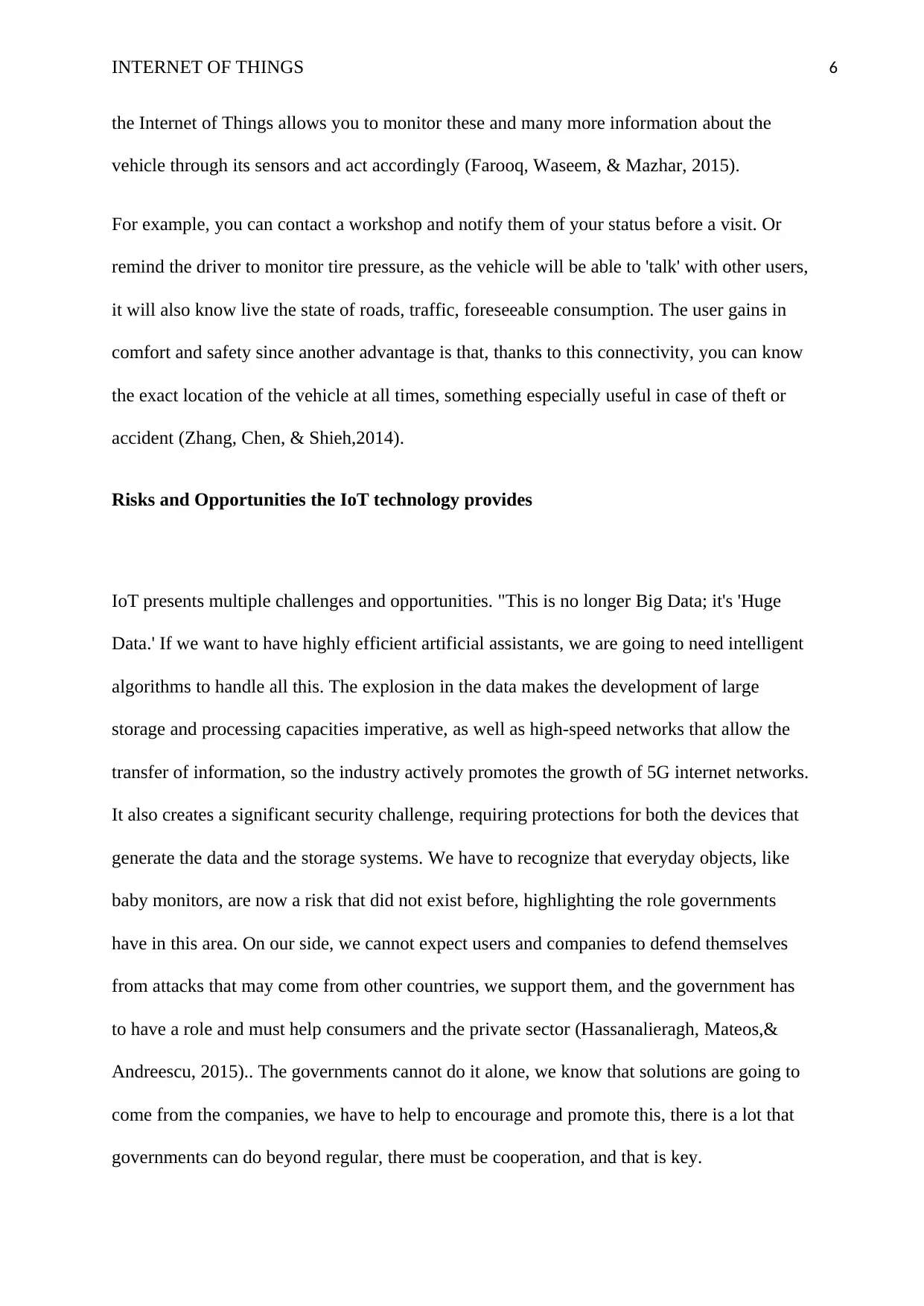
INTERNET OF THINGS 6
the Internet of Things allows you to monitor these and many more information about the
vehicle through its sensors and act accordingly (Farooq, Waseem, & Mazhar, 2015).
For example, you can contact a workshop and notify them of your status before a visit. Or
remind the driver to monitor tire pressure, as the vehicle will be able to 'talk' with other users,
it will also know live the state of roads, traffic, foreseeable consumption. The user gains in
comfort and safety since another advantage is that, thanks to this connectivity, you can know
the exact location of the vehicle at all times, something especially useful in case of theft or
accident (Zhang, Chen, & Shieh,2014).
Risks and Opportunities the IoT technology provides
IoT presents multiple challenges and opportunities. "This is no longer Big Data; it's 'Huge
Data.' If we want to have highly efficient artificial assistants, we are going to need intelligent
algorithms to handle all this. The explosion in the data makes the development of large
storage and processing capacities imperative, as well as high-speed networks that allow the
transfer of information, so the industry actively promotes the growth of 5G internet networks.
It also creates a significant security challenge, requiring protections for both the devices that
generate the data and the storage systems. We have to recognize that everyday objects, like
baby monitors, are now a risk that did not exist before, highlighting the role governments
have in this area. On our side, we cannot expect users and companies to defend themselves
from attacks that may come from other countries, we support them, and the government has
to have a role and must help consumers and the private sector (Hassanalieragh, Mateos,&
Andreescu, 2015).. The governments cannot do it alone, we know that solutions are going to
come from the companies, we have to help to encourage and promote this, there is a lot that
governments can do beyond regular, there must be cooperation, and that is key.
the Internet of Things allows you to monitor these and many more information about the
vehicle through its sensors and act accordingly (Farooq, Waseem, & Mazhar, 2015).
For example, you can contact a workshop and notify them of your status before a visit. Or
remind the driver to monitor tire pressure, as the vehicle will be able to 'talk' with other users,
it will also know live the state of roads, traffic, foreseeable consumption. The user gains in
comfort and safety since another advantage is that, thanks to this connectivity, you can know
the exact location of the vehicle at all times, something especially useful in case of theft or
accident (Zhang, Chen, & Shieh,2014).
Risks and Opportunities the IoT technology provides
IoT presents multiple challenges and opportunities. "This is no longer Big Data; it's 'Huge
Data.' If we want to have highly efficient artificial assistants, we are going to need intelligent
algorithms to handle all this. The explosion in the data makes the development of large
storage and processing capacities imperative, as well as high-speed networks that allow the
transfer of information, so the industry actively promotes the growth of 5G internet networks.
It also creates a significant security challenge, requiring protections for both the devices that
generate the data and the storage systems. We have to recognize that everyday objects, like
baby monitors, are now a risk that did not exist before, highlighting the role governments
have in this area. On our side, we cannot expect users and companies to defend themselves
from attacks that may come from other countries, we support them, and the government has
to have a role and must help consumers and the private sector (Hassanalieragh, Mateos,&
Andreescu, 2015).. The governments cannot do it alone, we know that solutions are going to
come from the companies, we have to help to encourage and promote this, there is a lot that
governments can do beyond regular, there must be cooperation, and that is key.
⊘ This is a preview!⊘
Do you want full access?
Subscribe today to unlock all pages.

Trusted by 1+ million students worldwide

INTERNET OF THINGS 7
Increasingly, the entrepreneur confirms the importance of innovation for the success or even
the survival of a company. Nowadays, change is not only a tool to improve competitiveness
and productivity, but it is also a strategic function. However, there is still a gap between the
conceptual phase and the practical application through Functional Innovation Plans. To
support companies in this process of implementation and monitoring of Innovation Plans, it is
necessary to know what their real innovative capacity is and to try to act on all those key
aspects to enhance, stimulate, channel and manage the formal and informal knowledge of the
people who constitute a company, area, department or group that has a common objective or
purpose (He, Yan, & Da Xu,2014). After that the organization must make an assessment of
the resources with which it has to evaluate and choose between different alternatives for
improvement, which will be implemented taking into account all of the above analyzed
(strategic objectives, clients and their satisfaction and available resources), to finish with a
general evaluation to appreciate in what degree improvements have been achieved In the
organization. This cycle must continuously be applied to maintain a continuous competitive
advantage.
SocialOpportunity/Risk matrix; Which is most IoT factor is Most desirable
A E F
C D B
Increased Opportunity VS Decreased Risk
A=Technology C= Products E=Competition
Increasingly, the entrepreneur confirms the importance of innovation for the success or even
the survival of a company. Nowadays, change is not only a tool to improve competitiveness
and productivity, but it is also a strategic function. However, there is still a gap between the
conceptual phase and the practical application through Functional Innovation Plans. To
support companies in this process of implementation and monitoring of Innovation Plans, it is
necessary to know what their real innovative capacity is and to try to act on all those key
aspects to enhance, stimulate, channel and manage the formal and informal knowledge of the
people who constitute a company, area, department or group that has a common objective or
purpose (He, Yan, & Da Xu,2014). After that the organization must make an assessment of
the resources with which it has to evaluate and choose between different alternatives for
improvement, which will be implemented taking into account all of the above analyzed
(strategic objectives, clients and their satisfaction and available resources), to finish with a
general evaluation to appreciate in what degree improvements have been achieved In the
organization. This cycle must continuously be applied to maintain a continuous competitive
advantage.
SocialOpportunity/Risk matrix; Which is most IoT factor is Most desirable
A E F
C D B
Increased Opportunity VS Decreased Risk
A=Technology C= Products E=Competition
Paraphrase This Document
Need a fresh take? Get an instant paraphrase of this document with our AI Paraphraser
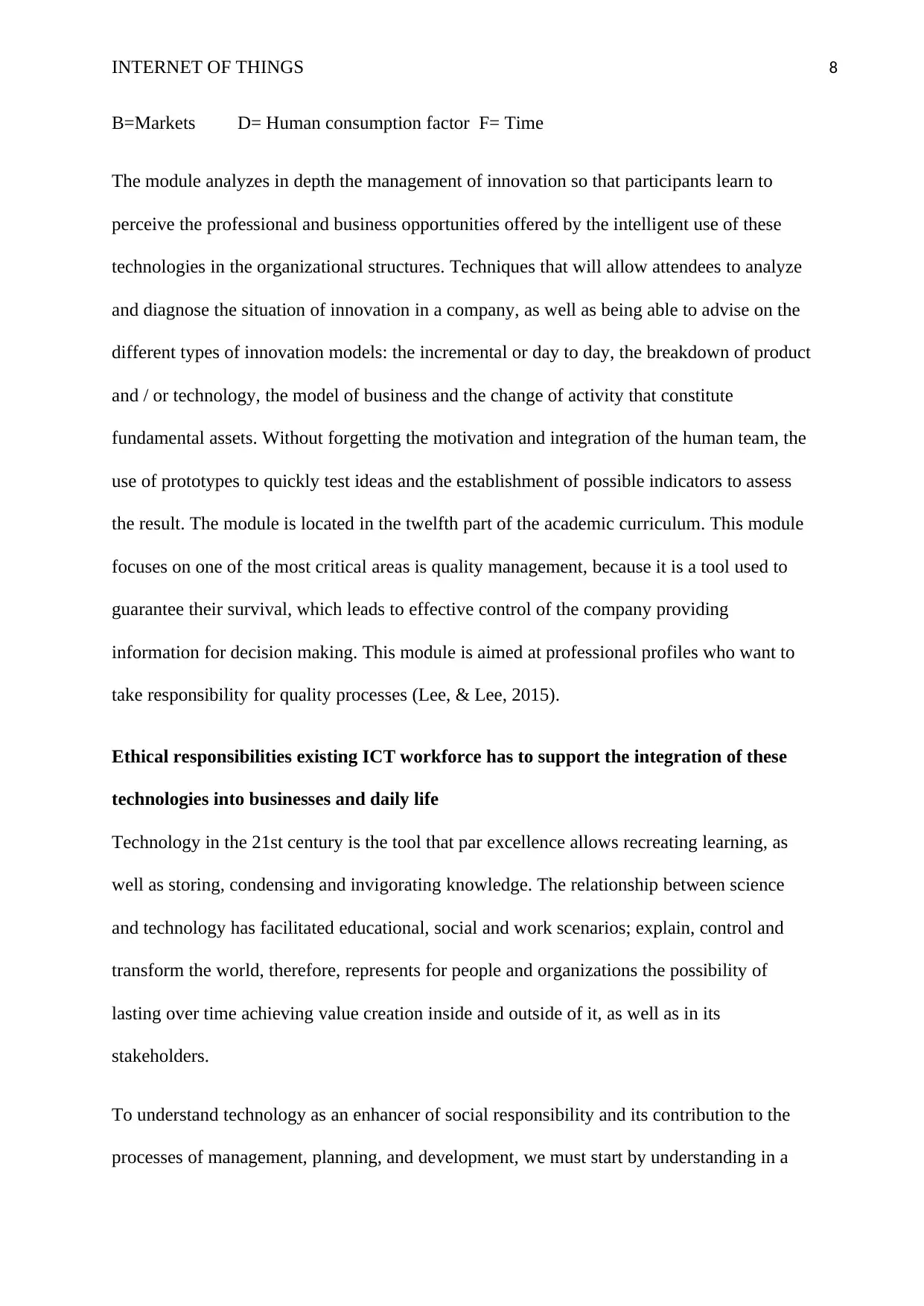
INTERNET OF THINGS 8
B=Markets D= Human consumption factor F= Time
The module analyzes in depth the management of innovation so that participants learn to
perceive the professional and business opportunities offered by the intelligent use of these
technologies in the organizational structures. Techniques that will allow attendees to analyze
and diagnose the situation of innovation in a company, as well as being able to advise on the
different types of innovation models: the incremental or day to day, the breakdown of product
and / or technology, the model of business and the change of activity that constitute
fundamental assets. Without forgetting the motivation and integration of the human team, the
use of prototypes to quickly test ideas and the establishment of possible indicators to assess
the result. The module is located in the twelfth part of the academic curriculum. This module
focuses on one of the most critical areas is quality management, because it is a tool used to
guarantee their survival, which leads to effective control of the company providing
information for decision making. This module is aimed at professional profiles who want to
take responsibility for quality processes (Lee, & Lee, 2015).
Ethical responsibilities existing ICT workforce has to support the integration of these
technologies into businesses and daily life
Technology in the 21st century is the tool that par excellence allows recreating learning, as
well as storing, condensing and invigorating knowledge. The relationship between science
and technology has facilitated educational, social and work scenarios; explain, control and
transform the world, therefore, represents for people and organizations the possibility of
lasting over time achieving value creation inside and outside of it, as well as in its
stakeholders.
To understand technology as an enhancer of social responsibility and its contribution to the
processes of management, planning, and development, we must start by understanding in a
B=Markets D= Human consumption factor F= Time
The module analyzes in depth the management of innovation so that participants learn to
perceive the professional and business opportunities offered by the intelligent use of these
technologies in the organizational structures. Techniques that will allow attendees to analyze
and diagnose the situation of innovation in a company, as well as being able to advise on the
different types of innovation models: the incremental or day to day, the breakdown of product
and / or technology, the model of business and the change of activity that constitute
fundamental assets. Without forgetting the motivation and integration of the human team, the
use of prototypes to quickly test ideas and the establishment of possible indicators to assess
the result. The module is located in the twelfth part of the academic curriculum. This module
focuses on one of the most critical areas is quality management, because it is a tool used to
guarantee their survival, which leads to effective control of the company providing
information for decision making. This module is aimed at professional profiles who want to
take responsibility for quality processes (Lee, & Lee, 2015).
Ethical responsibilities existing ICT workforce has to support the integration of these
technologies into businesses and daily life
Technology in the 21st century is the tool that par excellence allows recreating learning, as
well as storing, condensing and invigorating knowledge. The relationship between science
and technology has facilitated educational, social and work scenarios; explain, control and
transform the world, therefore, represents for people and organizations the possibility of
lasting over time achieving value creation inside and outside of it, as well as in its
stakeholders.
To understand technology as an enhancer of social responsibility and its contribution to the
processes of management, planning, and development, we must start by understanding in a
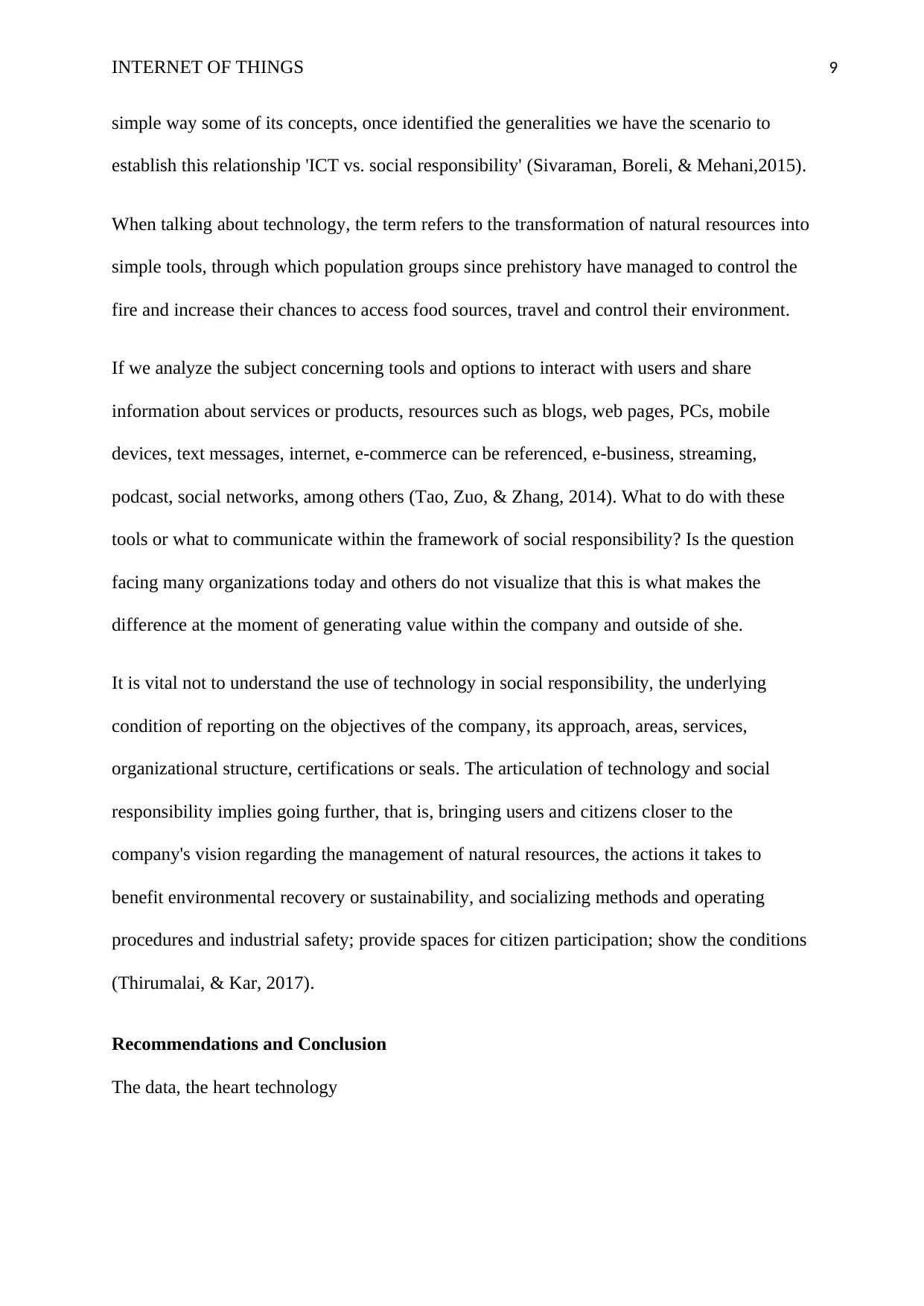
INTERNET OF THINGS 9
simple way some of its concepts, once identified the generalities we have the scenario to
establish this relationship 'ICT vs. social responsibility' (Sivaraman, Boreli, & Mehani,2015).
When talking about technology, the term refers to the transformation of natural resources into
simple tools, through which population groups since prehistory have managed to control the
fire and increase their chances to access food sources, travel and control their environment.
If we analyze the subject concerning tools and options to interact with users and share
information about services or products, resources such as blogs, web pages, PCs, mobile
devices, text messages, internet, e-commerce can be referenced, e-business, streaming,
podcast, social networks, among others (Tao, Zuo, & Zhang, 2014). What to do with these
tools or what to communicate within the framework of social responsibility? Is the question
facing many organizations today and others do not visualize that this is what makes the
difference at the moment of generating value within the company and outside of she.
It is vital not to understand the use of technology in social responsibility, the underlying
condition of reporting on the objectives of the company, its approach, areas, services,
organizational structure, certifications or seals. The articulation of technology and social
responsibility implies going further, that is, bringing users and citizens closer to the
company's vision regarding the management of natural resources, the actions it takes to
benefit environmental recovery or sustainability, and socializing methods and operating
procedures and industrial safety; provide spaces for citizen participation; show the conditions
(Thirumalai, & Kar, 2017).
Recommendations and Conclusion
The data, the heart technology
simple way some of its concepts, once identified the generalities we have the scenario to
establish this relationship 'ICT vs. social responsibility' (Sivaraman, Boreli, & Mehani,2015).
When talking about technology, the term refers to the transformation of natural resources into
simple tools, through which population groups since prehistory have managed to control the
fire and increase their chances to access food sources, travel and control their environment.
If we analyze the subject concerning tools and options to interact with users and share
information about services or products, resources such as blogs, web pages, PCs, mobile
devices, text messages, internet, e-commerce can be referenced, e-business, streaming,
podcast, social networks, among others (Tao, Zuo, & Zhang, 2014). What to do with these
tools or what to communicate within the framework of social responsibility? Is the question
facing many organizations today and others do not visualize that this is what makes the
difference at the moment of generating value within the company and outside of she.
It is vital not to understand the use of technology in social responsibility, the underlying
condition of reporting on the objectives of the company, its approach, areas, services,
organizational structure, certifications or seals. The articulation of technology and social
responsibility implies going further, that is, bringing users and citizens closer to the
company's vision regarding the management of natural resources, the actions it takes to
benefit environmental recovery or sustainability, and socializing methods and operating
procedures and industrial safety; provide spaces for citizen participation; show the conditions
(Thirumalai, & Kar, 2017).
Recommendations and Conclusion
The data, the heart technology
⊘ This is a preview!⊘
Do you want full access?
Subscribe today to unlock all pages.

Trusted by 1+ million students worldwide
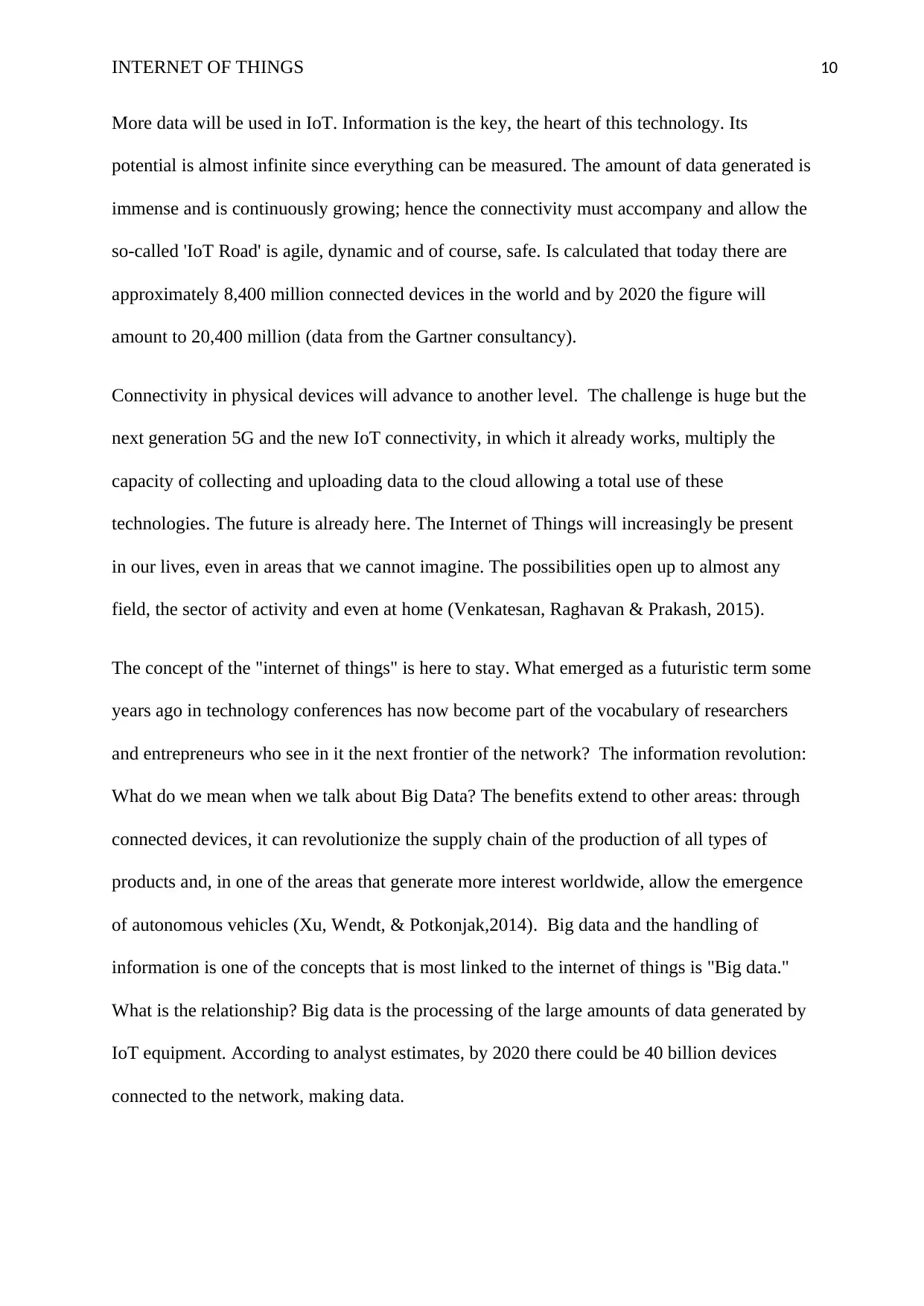
INTERNET OF THINGS 10
More data will be used in IoT. Information is the key, the heart of this technology. Its
potential is almost infinite since everything can be measured. The amount of data generated is
immense and is continuously growing; hence the connectivity must accompany and allow the
so-called 'IoT Road' is agile, dynamic and of course, safe. Is calculated that today there are
approximately 8,400 million connected devices in the world and by 2020 the figure will
amount to 20,400 million (data from the Gartner consultancy).
Connectivity in physical devices will advance to another level. The challenge is huge but the
next generation 5G and the new IoT connectivity, in which it already works, multiply the
capacity of collecting and uploading data to the cloud allowing a total use of these
technologies. The future is already here. The Internet of Things will increasingly be present
in our lives, even in areas that we cannot imagine. The possibilities open up to almost any
field, the sector of activity and even at home (Venkatesan, Raghavan & Prakash, 2015).
The concept of the "internet of things" is here to stay. What emerged as a futuristic term some
years ago in technology conferences has now become part of the vocabulary of researchers
and entrepreneurs who see in it the next frontier of the network? The information revolution:
What do we mean when we talk about Big Data? The benefits extend to other areas: through
connected devices, it can revolutionize the supply chain of the production of all types of
products and, in one of the areas that generate more interest worldwide, allow the emergence
of autonomous vehicles (Xu, Wendt, & Potkonjak,2014). Big data and the handling of
information is one of the concepts that is most linked to the internet of things is "Big data."
What is the relationship? Big data is the processing of the large amounts of data generated by
IoT equipment. According to analyst estimates, by 2020 there could be 40 billion devices
connected to the network, making data.
More data will be used in IoT. Information is the key, the heart of this technology. Its
potential is almost infinite since everything can be measured. The amount of data generated is
immense and is continuously growing; hence the connectivity must accompany and allow the
so-called 'IoT Road' is agile, dynamic and of course, safe. Is calculated that today there are
approximately 8,400 million connected devices in the world and by 2020 the figure will
amount to 20,400 million (data from the Gartner consultancy).
Connectivity in physical devices will advance to another level. The challenge is huge but the
next generation 5G and the new IoT connectivity, in which it already works, multiply the
capacity of collecting and uploading data to the cloud allowing a total use of these
technologies. The future is already here. The Internet of Things will increasingly be present
in our lives, even in areas that we cannot imagine. The possibilities open up to almost any
field, the sector of activity and even at home (Venkatesan, Raghavan & Prakash, 2015).
The concept of the "internet of things" is here to stay. What emerged as a futuristic term some
years ago in technology conferences has now become part of the vocabulary of researchers
and entrepreneurs who see in it the next frontier of the network? The information revolution:
What do we mean when we talk about Big Data? The benefits extend to other areas: through
connected devices, it can revolutionize the supply chain of the production of all types of
products and, in one of the areas that generate more interest worldwide, allow the emergence
of autonomous vehicles (Xu, Wendt, & Potkonjak,2014). Big data and the handling of
information is one of the concepts that is most linked to the internet of things is "Big data."
What is the relationship? Big data is the processing of the large amounts of data generated by
IoT equipment. According to analyst estimates, by 2020 there could be 40 billion devices
connected to the network, making data.
Paraphrase This Document
Need a fresh take? Get an instant paraphrase of this document with our AI Paraphraser
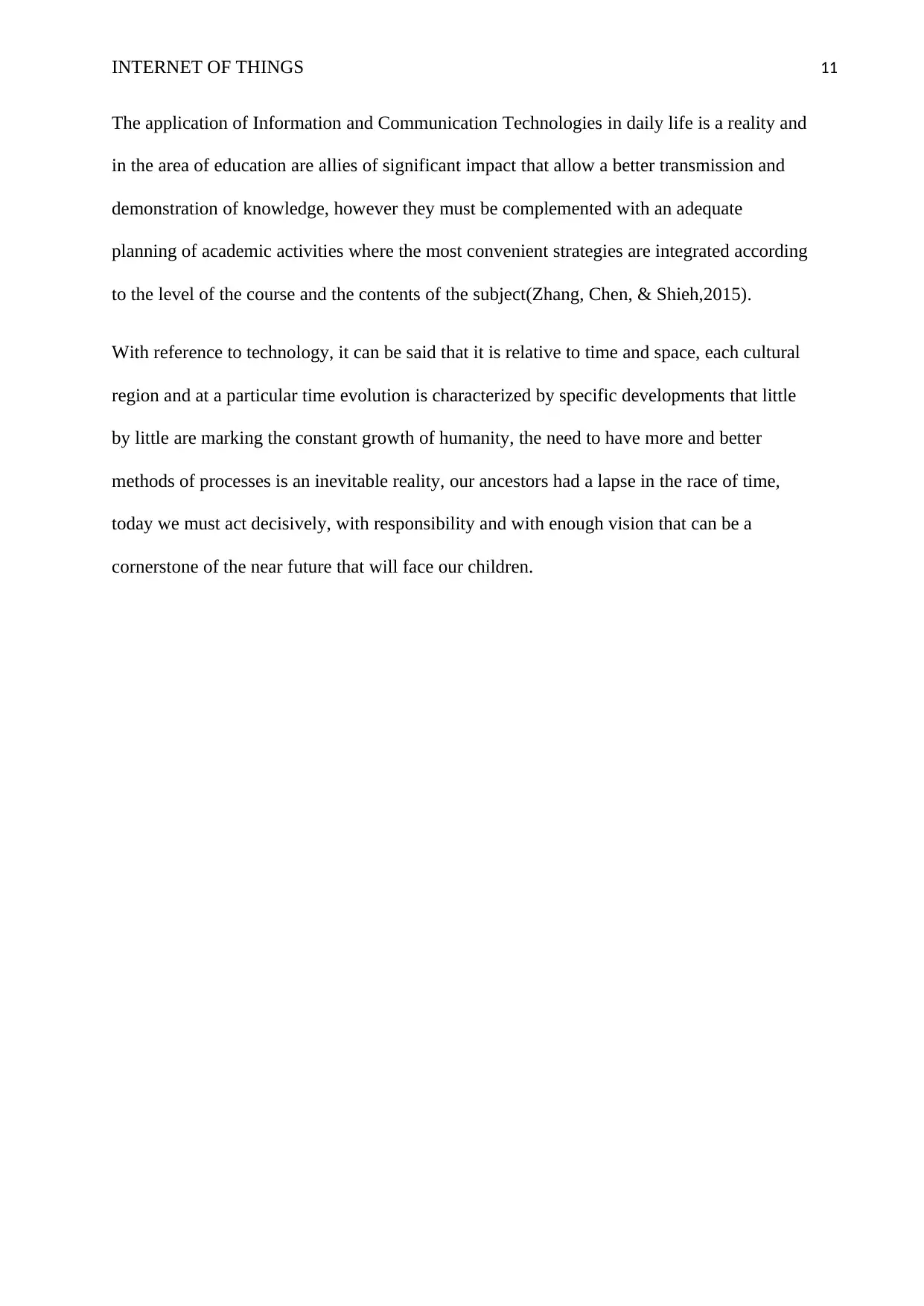
INTERNET OF THINGS 11
The application of Information and Communication Technologies in daily life is a reality and
in the area of education are allies of significant impact that allow a better transmission and
demonstration of knowledge, however they must be complemented with an adequate
planning of academic activities where the most convenient strategies are integrated according
to the level of the course and the contents of the subject(Zhang, Chen, & Shieh,2015).
With reference to technology, it can be said that it is relative to time and space, each cultural
region and at a particular time evolution is characterized by specific developments that little
by little are marking the constant growth of humanity, the need to have more and better
methods of processes is an inevitable reality, our ancestors had a lapse in the race of time,
today we must act decisively, with responsibility and with enough vision that can be a
cornerstone of the near future that will face our children.
The application of Information and Communication Technologies in daily life is a reality and
in the area of education are allies of significant impact that allow a better transmission and
demonstration of knowledge, however they must be complemented with an adequate
planning of academic activities where the most convenient strategies are integrated according
to the level of the course and the contents of the subject(Zhang, Chen, & Shieh,2015).
With reference to technology, it can be said that it is relative to time and space, each cultural
region and at a particular time evolution is characterized by specific developments that little
by little are marking the constant growth of humanity, the need to have more and better
methods of processes is an inevitable reality, our ancestors had a lapse in the race of time,
today we must act decisively, with responsibility and with enough vision that can be a
cornerstone of the near future that will face our children.
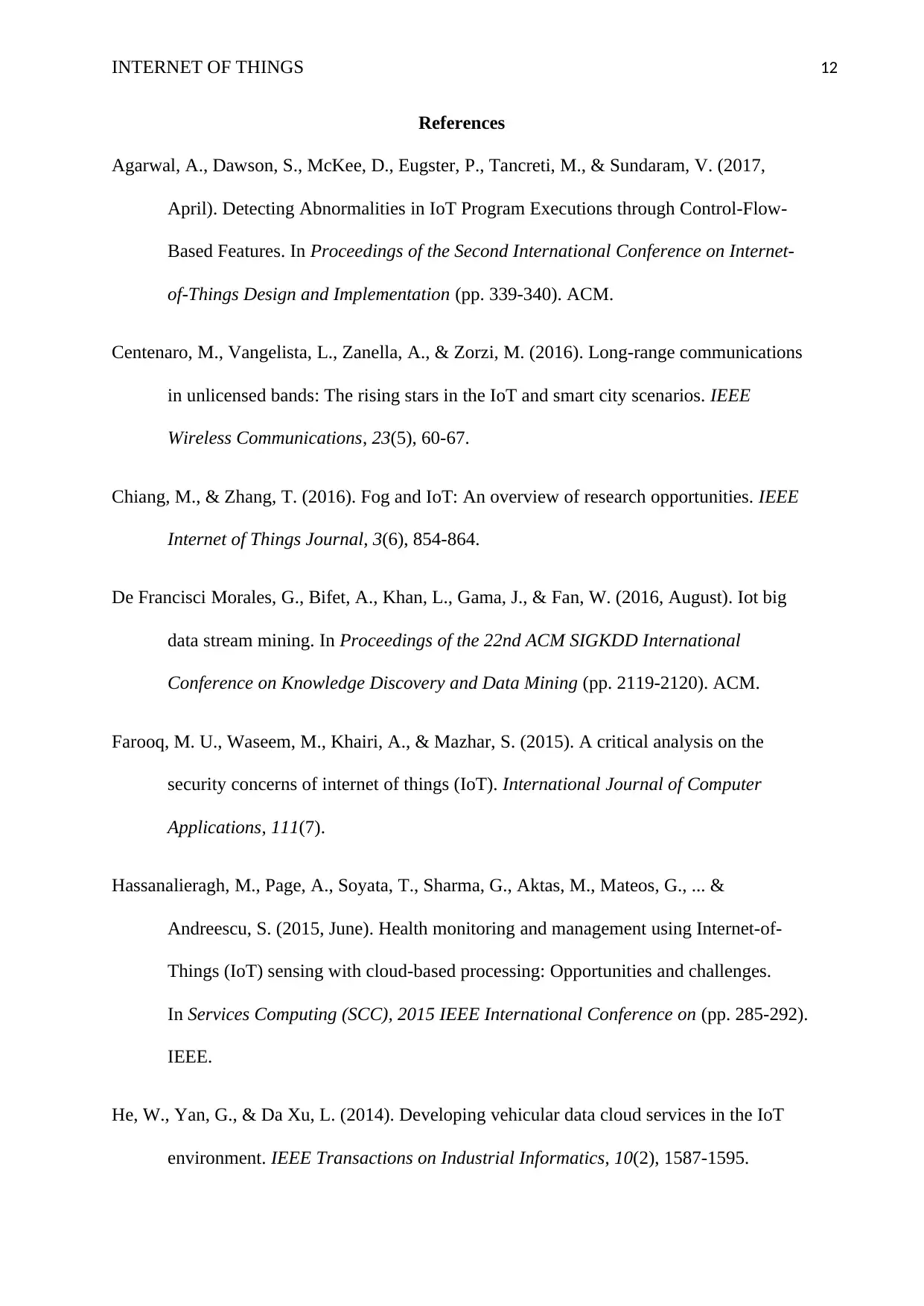
INTERNET OF THINGS 12
References
Agarwal, A., Dawson, S., McKee, D., Eugster, P., Tancreti, M., & Sundaram, V. (2017,
April). Detecting Abnormalities in IoT Program Executions through Control-Flow-
Based Features. In Proceedings of the Second International Conference on Internet-
of-Things Design and Implementation (pp. 339-340). ACM.
Centenaro, M., Vangelista, L., Zanella, A., & Zorzi, M. (2016). Long-range communications
in unlicensed bands: The rising stars in the IoT and smart city scenarios. IEEE
Wireless Communications, 23(5), 60-67.
Chiang, M., & Zhang, T. (2016). Fog and IoT: An overview of research opportunities. IEEE
Internet of Things Journal, 3(6), 854-864.
De Francisci Morales, G., Bifet, A., Khan, L., Gama, J., & Fan, W. (2016, August). Iot big
data stream mining. In Proceedings of the 22nd ACM SIGKDD International
Conference on Knowledge Discovery and Data Mining (pp. 2119-2120). ACM.
Farooq, M. U., Waseem, M., Khairi, A., & Mazhar, S. (2015). A critical analysis on the
security concerns of internet of things (IoT). International Journal of Computer
Applications, 111(7).
Hassanalieragh, M., Page, A., Soyata, T., Sharma, G., Aktas, M., Mateos, G., ... &
Andreescu, S. (2015, June). Health monitoring and management using Internet-of-
Things (IoT) sensing with cloud-based processing: Opportunities and challenges.
In Services Computing (SCC), 2015 IEEE International Conference on (pp. 285-292).
IEEE.
He, W., Yan, G., & Da Xu, L. (2014). Developing vehicular data cloud services in the IoT
environment. IEEE Transactions on Industrial Informatics, 10(2), 1587-1595.
References
Agarwal, A., Dawson, S., McKee, D., Eugster, P., Tancreti, M., & Sundaram, V. (2017,
April). Detecting Abnormalities in IoT Program Executions through Control-Flow-
Based Features. In Proceedings of the Second International Conference on Internet-
of-Things Design and Implementation (pp. 339-340). ACM.
Centenaro, M., Vangelista, L., Zanella, A., & Zorzi, M. (2016). Long-range communications
in unlicensed bands: The rising stars in the IoT and smart city scenarios. IEEE
Wireless Communications, 23(5), 60-67.
Chiang, M., & Zhang, T. (2016). Fog and IoT: An overview of research opportunities. IEEE
Internet of Things Journal, 3(6), 854-864.
De Francisci Morales, G., Bifet, A., Khan, L., Gama, J., & Fan, W. (2016, August). Iot big
data stream mining. In Proceedings of the 22nd ACM SIGKDD International
Conference on Knowledge Discovery and Data Mining (pp. 2119-2120). ACM.
Farooq, M. U., Waseem, M., Khairi, A., & Mazhar, S. (2015). A critical analysis on the
security concerns of internet of things (IoT). International Journal of Computer
Applications, 111(7).
Hassanalieragh, M., Page, A., Soyata, T., Sharma, G., Aktas, M., Mateos, G., ... &
Andreescu, S. (2015, June). Health monitoring and management using Internet-of-
Things (IoT) sensing with cloud-based processing: Opportunities and challenges.
In Services Computing (SCC), 2015 IEEE International Conference on (pp. 285-292).
IEEE.
He, W., Yan, G., & Da Xu, L. (2014). Developing vehicular data cloud services in the IoT
environment. IEEE Transactions on Industrial Informatics, 10(2), 1587-1595.
⊘ This is a preview!⊘
Do you want full access?
Subscribe today to unlock all pages.

Trusted by 1+ million students worldwide
1 out of 14
Related Documents
Your All-in-One AI-Powered Toolkit for Academic Success.
+13062052269
info@desklib.com
Available 24*7 on WhatsApp / Email
![[object Object]](/_next/static/media/star-bottom.7253800d.svg)
Unlock your academic potential
Copyright © 2020–2025 A2Z Services. All Rights Reserved. Developed and managed by ZUCOL.





